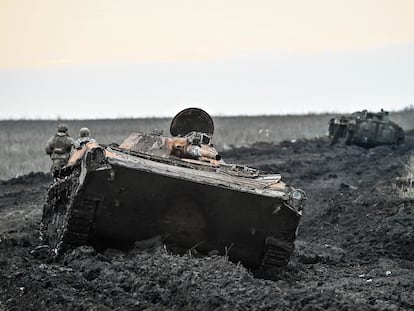Ukraine relies on ‘kamikaze’ drones, dwindling artillery, and infantry to defend its advances in Robotyne
Moscow troops have besieged the enclave liberated in the failed summer counteroffensive, but Kyiv’s forces have managed to stop them without exposing their armor and with ammunition running short
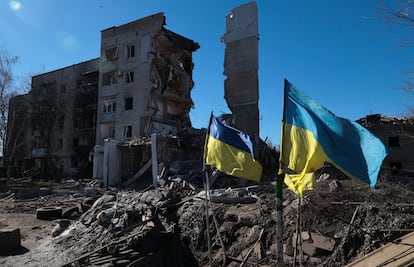
In a flat terrain, with hardly any buildings for cover, and the few hills to the east and south occupied by enemy artillery, the effort made by the Ukrainian army to repel the Russian invader on the Robotyne front (in the Zaporizhzhia region of southeastern Ukraine) is immense. This is not the time to attack, like in the summer, when Kyiv’s troops were well supplied by the West during their failed counteroffensive, and they managed to recapture the land on which this now empty village stands.
Every day, hundreds of soldiers from Kyiv walk the 6 miles that separate their drop-off point from combat positions facing the Kremlin’s forces. There is no going back. FPV (First Person Vision) kamikaze drones prevent armored vehicles from evacuating the wounded. Only on foot can they return, exposed all the while to these unmanned explosive vehicles. Despite this, their commanders affirm that they have not lost ground. The casualties of the aggressor’s army — dead and wounded — are triple their own, they say. There’s no turning back.
Units of at least nine Russian regiments — airborne, motorized, and air assault — have besieged this small pocket of land of about 30 square miles liberated by Ukraine last August on its southern front. The invader’s rockets and howitzers relentlessly punish the rear and have reduced the settlements of Orikhiv and Mala Tokmachka, about 5 miles north of the combat zone, to rubble.
Guided bombs launched by Moscow’s air force also land here. Their destructive power leaves craters up to 50 feet in diameter. Almost all the residential buildings in these towns are totally or partially destroyed. The residents — except for a handful of elderly and impoverished people — have fled (14,000 people lived in Orikhiv alone during peacetime). A contingent of about 25,000 soldiers, sheltered underground or hiding out in homes dotted throughout this agricultural area, has replaced them. The noise of cannon fire and explosions from both sides is constant, almost rhythmic.
This is one of the points where the Russian army has concentrated its troops in the advance that began in December. The importance of Robotyne is more symbolic than strategic — it was Ukraine’s most celebrated conquest during its counterattack last summer — but, according to analysts, the siege serves to weaken Kyiv’s forces against the Kremlin’s main military objective in the east.
Moscow wants to occupy what little is left of the Luhansk region in the northeast that is currently not under its control, and to advance towards Kharkiv from there. After the Ukrainian withdrawal from Avdiivka, it also seeks to take over the entire Donetsk region, according to the Institute for the Study of War (ISW), based in Washington.
The offensive in Robotyne and further west on the left bank of the Dnipro, in Kherson province, seeks to prevent Kyiv from concentrating its men in places where the Russians want to make more significant advances. Unlike in Donbas, the Kremlin’s troops have not managed to occupy more ground in Robotyne and Kherson.
The plan has not succeeded, but the Ukrainians are paying a high cost and are struggling with an increasingly evident lack of artillery ammunition. “Their tactics are always the same,” a Ukrainian special forces commander stationed at Robotyne explains. “They send waves of small formations of between four and six soldiers. The first acts as a scout unit to locate us. They advance, and when we fire to defend ourselves, they learn our position. Then comes another small group supported by FPV drones that tries to take out our men. Finally, a third group tries to take over our combat post,” the soldier (who has received training in Germany and the United Kingdom) adds. “The only way to stop them is to resort to our drones, with grenade launchers, mortar fire, or artillery.”
The latter, artillery ammunition, is the main problem. They are running short on both the 82 caliber mortar projectiles and the Soviet 120 millimeter and 155 millimeter howitzers, the latter supplied by NATO. “But what we need most are the 105 caliber [those used by the American-made M-101 cannons],” says another of the Ukrainian commanders.
These howitzers have a range of more than 7 miles. “We receive that ammunition every week, but it is not enough. “That is the most important projectile, because it allows us to cover our soldiers on the ground.” This Friday alone, Robotyne and the rest of the Zaporizhzhia front received six attacks with Russian MLRS rocket batteries and 218 artillery hits, as well as 79 drone incursions, according to the state administration in the region.
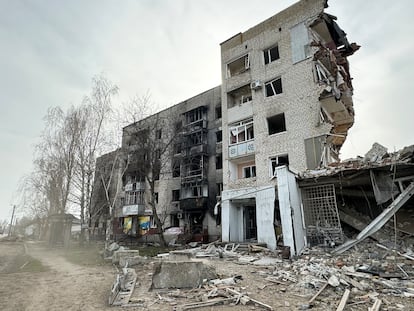
A flock of chickens and a couple of dogs run through the yard of a country house less than 6 miles from the front. The place looks like a rural lodge, but a Humvee (high mobility multipurpose military vehicle) hidden under the trees and covered by camouflage fabric is a clue that this is military land. Inside this half-ruined, abandoned house live three Ukrainian soldiers with roles in intelligence.
They work in a tiny cabin lined with silver asphalt coating to insulate themselves from the cold and not be detected by thermal devices deployed by the enemy. Among children’s drawings, a Ukrainian flag, and military-themed posters is the device they are working with. A laptop connected to a television shows the images of the front, obtained by the cameras of about twenty Mavic-type exploration drones. They only have to zoom in to see enemy soldiers crawling through trenches covered in leaves and logs.
“Our job is to monitor the movement of Russian troops and armor,” explains one of the men, a 26-year-old whose nickname is Kotya (little cat). “When we see that four or five are grouped together at the same point, we notify our superiors,” he continues. Another unit is then in charge of sending another kamikaze-type unmanned aerial vehicle to the enemy’s location and launches itself at them.
While Kotya explains what he does, the monitor shows it live. A Ukrainian drone is launched against enemy forces. Those who have managed to survive the impact crawl out of their hiding place, dragging themselves along the ground. A few minutes later, three armored vehicles appear on the screen. The soldier zooms in with the telephoto lens. “They are not attack vehicles. They are the ones in charge of demining the land,” he says. “We don’t have to report on those,” he adds. And he clicks on the images from another drone on his laptop.
The unit that Kotya is part of was made up of 23 soldiers, but at the end of autumn, the impact of an artillery shell left 17 comrades unfit for combat. One died and 16 suffered injuries that did not allow them to continue on the front. Until then, they alternated drone control work with reconnaissance expeditions, but they can no longer do them. “We have been waiting for the replacements for months. They told us that new colleagues would arrive, but, for the moment, no one else has turned up,” says one of his colleagues, a 25-year-old whose code name is Sova (cuckoo).
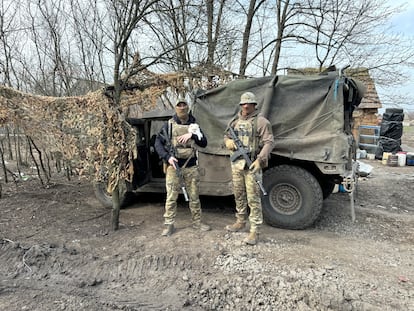
Fatigue and understaffing are behind a serious mistake Ukraine has made on this front in recent days. The Russian Defense Ministry said Thursday that its soldiers had taken over an important building in Robotyne. The commander-in-chief of the Ukrainian army, Oleksandr Syrskyi, reacted by stating that some of the commanders had made “miscalculations” when “assessing the enemy” and promised to send more weapons, ammunition, and personnel. “The problem is that the brigade units that fought that day were exhausted, but now it has been solved,” the head of the special forces on the ground explains. He says that the territory lost four days ago has now been recovered.
This commander, however, does not hide his concern about the difficulty of replacing and rotating troops. “We need people who are prepared. We receive many young people who we ourselves are in charge of training,” he continues. “If you are defending yourself from the invader, it is essential that people can rest, because what they are experiencing is very hard,” he adds. “Our soldiers can do it, but they have fewer and fewer days off.”
Defend and do not attack. Leave the initiative to the aggressor. That’s what Ukraine is doing in Robotyne and on the rest of the front. The country has gone “from an offensive to a defensive operation,” in the words of Syrskyi, the army chief. It’s time to save ammunition while new supplies arrive. Avoid the loss of men as much as possible. Preserve their lives.
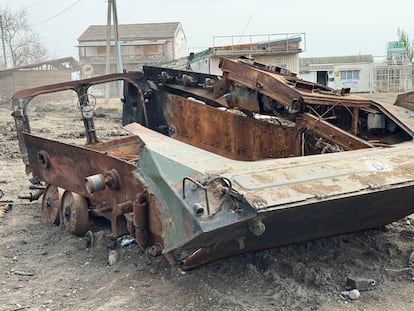
Sign up for our weekly newsletter to get more English-language news coverage from EL PAÍS USA Edition
Tu suscripción se está usando en otro dispositivo
¿Quieres añadir otro usuario a tu suscripción?
Si continúas leyendo en este dispositivo, no se podrá leer en el otro.
FlechaTu suscripción se está usando en otro dispositivo y solo puedes acceder a EL PAÍS desde un dispositivo a la vez.
Si quieres compartir tu cuenta, cambia tu suscripción a la modalidad Premium, así podrás añadir otro usuario. Cada uno accederá con su propia cuenta de email, lo que os permitirá personalizar vuestra experiencia en EL PAÍS.
¿Tienes una suscripción de empresa? Accede aquí para contratar más cuentas.
En el caso de no saber quién está usando tu cuenta, te recomendamos cambiar tu contraseña aquí.
Si decides continuar compartiendo tu cuenta, este mensaje se mostrará en tu dispositivo y en el de la otra persona que está usando tu cuenta de forma indefinida, afectando a tu experiencia de lectura. Puedes consultar aquí los términos y condiciones de la suscripción digital.
More information
Últimas noticias
Most viewed
- Sinaloa Cartel war is taking its toll on Los Chapitos
- Oona Chaplin: ‘I told James Cameron that I was living in a treehouse and starting a permaculture project with a friend’
- Reinhard Genzel, Nobel laureate in physics: ‘One-minute videos will never give you the truth’
- Why the price of coffee has skyrocketed: from Brazilian plantations to specialty coffee houses
- Silver prices are going crazy: This is what’s fueling the rally

